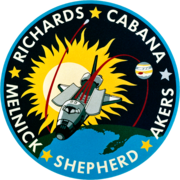STS-41

Discovery launches from Launch Complex 39B, with Columbia in view from its position on LC-39A.
|
|
| Mission type | Spacecraft deployment |
|---|---|
| Operator | NASA |
| COSPAR ID | 1990-090A |
| SATCAT no. | 20841 |
| Mission duration | 4 days, 2 hours, 10 minutes, 4 seconds |
| Distance travelled | 2,747,866 kilometers (1,707,445 mi) |
| Orbits completed | 66 |
| Spacecraft properties | |
| Spacecraft | Space Shuttle Discovery |
| Launch mass | 117,749 kilograms (259,592 lb) |
| Landing mass | 89,298 kilograms (196,868 lb) |
| Payload mass | 28,451 kilograms (62,724 lb) |
| Crew | |
| Crew size | 5 |
| Members |
Richard N. Richards Robert D. Cabana Bruce E. Melnick William M. Shepherd Thomas D. Akers |
| Start of mission | |
| Launch date | 6 October 1990, 11:47:15 UTC |
| Launch site | Kennedy LC-39B |
| End of mission | |
| Landing date | 10 October 1990, 13:57:18 UTC |
| Landing site | Edwards Runway 22 |
| Orbital parameters | |
| Reference system | Geocentric |
| Regime | Low Earth |
| Perigee | 300 kilometers (160 nmi) |
| Apogee | 307 kilometers (166 nmi) |
| Inclination | 28.45 degrees |
| Period | 90.6 min |
 (L–R): Melnick, Cabana, Akers, Richards, Shepherd are pictured in front of the T-38 jet trainer |
|
STS-41 was the eleventh mission of the Space Shuttle Discovery. The four-day mission with a primary objective to launch the Ulysses probe as part of the "International Solar Polar Mission".
Discovery lifted off on 6 October 1990 at 7:47:15 am EDT. Liftoff occurred 12 minutes after a two-and-a-half-hour launch window opened that day at 7:35 am EDT. STS-41 featured the heaviest payload to date; Discovery weighed 259,593 lb (117 749 Kg) .
The primary payload was the ESA-built Ulysses spacecraft to explore the polar regions of Sun. Attached to Ulysses were two upper stages, the Inertial Upper Stage (IUS) and a mission-specific Payload Assist Module-S (PAM-S), combined together for first time to send Ulysses toward an out-of-ecliptic trajectory. Other payloads and experiments included the Shuttle Solar Backscatter Ultraviolet (SSBUV) experiment, INTELSAT Solar Array Coupon (ISAC), Chromosome and Plant Cell Division Experiment (CHROMEX), Voice Command System (VCS), Solid Surface Combustion Experiment (SSCE), Investigations into Polymer Membrane Processing (IPMP), Physiological Systems Experiment (PSE), Radiation Monitoring Experiment III (RME III), Shuttle Student Involvement Program (SSIP) and Air Force Maui Optical Site (AMOS).
Six hours after Discovery's launch, Ulysses was deployed from the payload bay. Ulysses, a joint project between the European Space Agency and NASA, was the first spacecraft to study the Sun's polar regions. Its voyage to the Sun began with a sixteen month trip to Jupiter where the planet's gravitational energy was used to fling Ulysses southward out of the orbital plane of the planets and on toward a solar south pole passage in 1994. The spacecraft crossed back over the orbital plane and made a solar north pole passage in 1995. By the time Discovery touched down at Edwards Air Force Base, Ulysses had already traversed one million miles (1.6 million km) on its five-year mission.
...
Wikipedia

